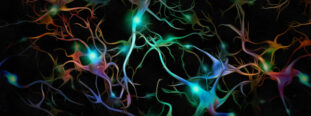Aliens inside us – Revisiting the viral theory of multiple sclerosis – ECTRIMS 2015
European Committee for Treatment and Research in MS (ECTRIMS) – 31st Congress – Barcelona, Spain, October 7-10, 2015 – Viruses have long been suspected to be the cause of multiple sclerosis. In fact, the first MS medications – the interferons – were tested in MS because of their antiviral properties. One of the usual suspects is Epstein-Barr virus (EBV), which causes infectious mononucleosis (for more on EBV see Does a virus cause multiple sclerosis? MSology, June 6, 2013).
The virus theory has several shortcomings, not least of which is that researchers have failed to show that a specific viral infection actually triggers the onset of MS.
But what if the enemy is us?
Over two decades ago, researchers speculated that the cause of MS (as well as other autoimmune and neurodegenerative diseases) may be HERV – human endogenous retroviruses. Viruses reproduce by plugging into our cells and using our own DNA machinery to manufacture viral components. Over the past few millennia, our ancestors have battled numerous viruses, and some of these have left bits of their viral nucleic acids (the building blocks of DNA) behind. In fact, an estimated 8% of the human genome is viral in origin. Virus genes have taken a beating over the years and most of these genetic sequences no longer function. However, at least one functional virus – later called the MS-associated retrovirus (MSRV) – has been identified in people with MS (Perron and colleagues. Res Virol 1989;140: 551-561).
Indeed, MSRV and other HERV components have been found in the brain, blood and spinal fluid of people with MS (Mameli and colleagues. J Gen Virol 2007;88:264-274), and have been shown to have the potential to damage nerve fibres and the cells that produce myelin (Antony and colleagues. Nat Neurosci 2004;7:1088-1095). Also intriguing is that MSRV/HERV activity waxes and wanes in parallel to the waxing and waning of MS flare-ups, prompting some to call viral genes “the aliens inside” (Dolei and colleagues. J Infect Dev Ctries 2015;9:577-587).
At this year’s ECTRIMS meeting, one group of researchers reviewed over 200 published reports of HERVs and MS to see if the evidence stood up to scrutiny (Morandi and colleagues. ECTRIMS 2015; abstract P907). They concluded that HERV expression does appear to be greater in people with MS compared to those without MS, and viruses may well play a role in the MS disease process. For example, if HERV activates the innate immune response in the brain, it may be one of the factors contributing to the irreversible disability that occurs in progressive MS.
This chapter of the MS story began with the misbegotten idea that antiviral drugs such as the interferons might be effective for MS. Interferons were useful treatments but not because of their antiviral effects, and viruses became a footnote to the story. The virus theory of MS is now making something of a comeback just as interferons are getting pushed off the stage by newer medications. But don’t count interferons out just yet. Interferons have been shown to reduce the activity of HERVs in people with MS (Petersen and colleagues. J Neuroimmunol 2012;249:105-108), so they may well reclaim some of their former prominence in the years ahead.
For more on HERVs, see New look at an old virus in multiple sclerosis. MSology, October 24, 2013.
Share this article
Facebook Twitter pin it! Email
Related Posts
Back





